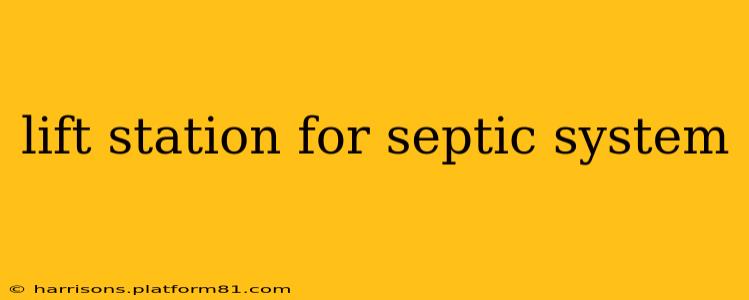A lift station for a septic system is a crucial component for homes or businesses located in areas with low-lying land or where gravity drainage isn't sufficient to effectively move wastewater to a septic tank or treatment plant. This guide will delve into the intricacies of lift stations, addressing common questions and concerns.
What is a Lift Station in a Septic System?
A lift station is essentially a small pumping station that uses a submersible pump to lift wastewater from a lower elevation to a higher one, overcoming the limitations of gravity. It's a critical piece of infrastructure in ensuring efficient wastewater disposal, preventing backups, and maintaining proper sanitation. These stations typically consist of a pump, a holding tank (wet well), a control panel, and an alarm system. The wastewater flows into the wet well, the pump activates when the level reaches a certain point, and the wastewater is then pumped to the septic tank or treatment facility.
How Does a Lift Station for a Septic System Work?
The process is relatively straightforward:
- Wastewater Collection: Wastewater flows into the wet well via pipes from the house or building.
- Level Sensing: A float switch or other level sensor monitors the wastewater level in the wet well.
- Pump Activation: When the wastewater reaches a pre-determined level, the sensor triggers the pump to activate.
- Pumping: The submersible pump moves the wastewater from the wet well to the discharge pipe.
- Discharge: The wastewater is then transported via the discharge pipe to the septic tank or treatment plant.
- Alarm System: An alarm system alerts property owners or maintenance personnel of any malfunctions, such as pump failure or high water levels.
What are the Different Types of Lift Stations?
Lift stations can vary based on size, pump type, and control system. Common types include:
- Submersible Pump Stations: These are the most common type, featuring a pump submerged directly in the wastewater.
- Dry Well Stations: The pump sits outside the wet well, reducing the risk of damage from submerged components.
How Often Does a Septic Lift Station Need Maintenance?
Regular maintenance is vital to ensure the longevity and efficient operation of your lift station. This typically includes:
- Pump Inspection: Regularly check the pump for wear and tear, debris, and potential damage.
- Wet Well Cleaning: Periodic cleaning of the wet well is necessary to remove accumulated solids and prevent clogging.
- Alarm System Testing: Ensure the alarm system is functioning correctly to prevent unexpected failures.
What are the Signs of a Failing Septic Lift Station?
Several signs indicate potential problems with your lift station:
- Slow Drains: This is a clear sign that the system might be struggling to move wastewater effectively.
- Gurgling Sounds: These sounds can indicate blockages or airlocks in the system.
- Sewage Backup: A backup of sewage is a serious issue requiring immediate attention.
- Frequent Alarm Activation: Constant triggering of the alarm system suggests a malfunctioning component.
How Much Does a Septic Lift Station Cost?
The cost of installing a septic lift station varies significantly based on factors such as the size of the system, the complexity of the installation, and the location. It's advisable to obtain quotes from multiple reputable contractors to get a clear understanding of the cost involved.
How Long Do Septic Lift Stations Last?
With proper maintenance and regular inspections, a well-maintained septic lift station can last for 10-20 years or even longer. The lifespan significantly depends on the quality of components and the frequency of maintenance.
What are the Common Problems with Septic Lift Stations?
Common problems include:
- Pump Failure: Pump wear and tear, clogging, or electrical failures are frequent issues.
- Clogged Pipes: Debris or roots can obstruct pipes, hindering wastewater flow.
- Electrical Issues: Power outages or malfunctioning control panels can disrupt operation.
Addressing these issues promptly is crucial to prevent larger, more costly problems down the line. Regular maintenance and inspections are key to preventing failures and ensuring the continued efficient operation of your septic lift station.
